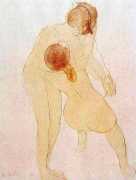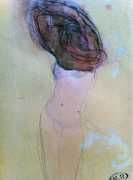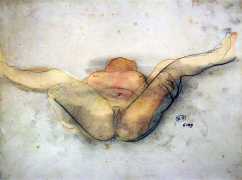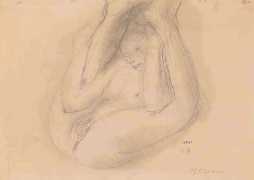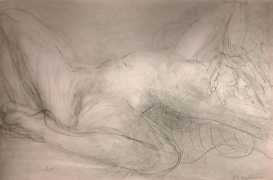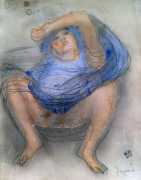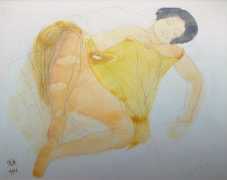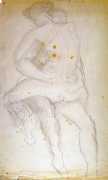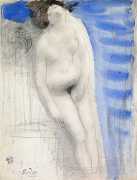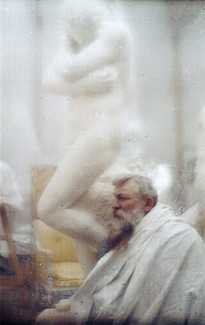
When asked about the importance of his drawings towards the end of his life, Auguste Rodin replied, ‘It’s very simple. My drawings are the key to my work.’ Rodin was a prolific draughtsman, producing around ten thousand drawings, over seven thousand of which are now in the Musée Rodin in Paris. His drawings were seldom used as studies or projects for a sculpture or monument, but were an essential element of his creative process, exploring line, form and pattern, especially in the human body.
Of these thousands of drawings, several hundred can be categorised as erotic, in that they depict bodies open, displayed, sharing, apparently unashamed. But it can be argued that for Rodin the distinction is relatively unimportant; he loved women, he loved drawing them, and for him breasts, hips and vulvas were as much part of the bodyscape as heads and arms.
A passage from Antoinette le Normand-Romain and Christina Berley-Uribe’s definitive survey of Rodin’s drawings (Auguste Rodin: Drawings and Watercolors, 2006) sets these drawings in context.
 The erotic drawings, based on the pose of one or several models or created by assembling cut-outs into lesbian couples, are an important but are not easily comprehensible aspect of Rodin’s work. Almost all display the genitals very clearly, with no sense of guilt or daring. But if one singles out those with a seeming erotic intent, it becomes clear that they are in a minority: most of the drawings that focus on the genitals in fact explore formal problems. In this long series Rodin continually experimented with the forms which the naked body can generate, as if when left to its own devices it could reveal novel formal structures. Rodin treated the genitals as the pole around which he could explore profiles, contours, surface, mass, modelling, relief, form and the occupation of space. If this experimentation takes on an erotic character, that is due to the endlessly repeated depiction of primary sexual characteristics such as the cleft and sometimes pubic hair, and secondary attributes such as the roundness of a breast or hip, the smoothness of an arm or leg, and nudity, which is sometimes suggested and sometimes displayed. The genitals are the geometric centre, like the point on which a compass rests, around which he organises forms. One drawing illustrates the relatively abstract role of the genitals in his work: looked at one way up, it shows a woman with her legs apart, seen from behind, bent over, with her head just below her genitals and her limbs sprouting from this core; looked at the other way up, the body takes on the form of a lotus flower. In the drawings usually categorised as erotic, not all ‘make use of attraction and desire’ (Didi-Huberman, 1999, p. 25). Many of Rodin’s nudes – some of the vase-women, for example – are not in the least erotic. Nor is Eros, the most fully worked out male nude, an erotic figure in itself: it is a study of leaning back so that the body forms an arc, of tension, even of spasm – despite the ‘erotic’ combinations with other figures that we have already noted, where the link is always via the genitals, but in a semi-humorous way, since this was not the focal point of the combination.
The erotic drawings, based on the pose of one or several models or created by assembling cut-outs into lesbian couples, are an important but are not easily comprehensible aspect of Rodin’s work. Almost all display the genitals very clearly, with no sense of guilt or daring. But if one singles out those with a seeming erotic intent, it becomes clear that they are in a minority: most of the drawings that focus on the genitals in fact explore formal problems. In this long series Rodin continually experimented with the forms which the naked body can generate, as if when left to its own devices it could reveal novel formal structures. Rodin treated the genitals as the pole around which he could explore profiles, contours, surface, mass, modelling, relief, form and the occupation of space. If this experimentation takes on an erotic character, that is due to the endlessly repeated depiction of primary sexual characteristics such as the cleft and sometimes pubic hair, and secondary attributes such as the roundness of a breast or hip, the smoothness of an arm or leg, and nudity, which is sometimes suggested and sometimes displayed. The genitals are the geometric centre, like the point on which a compass rests, around which he organises forms. One drawing illustrates the relatively abstract role of the genitals in his work: looked at one way up, it shows a woman with her legs apart, seen from behind, bent over, with her head just below her genitals and her limbs sprouting from this core; looked at the other way up, the body takes on the form of a lotus flower. In the drawings usually categorised as erotic, not all ‘make use of attraction and desire’ (Didi-Huberman, 1999, p. 25). Many of Rodin’s nudes – some of the vase-women, for example – are not in the least erotic. Nor is Eros, the most fully worked out male nude, an erotic figure in itself: it is a study of leaning back so that the body forms an arc, of tension, even of spasm – despite the ‘erotic’ combinations with other figures that we have already noted, where the link is always via the genitals, but in a semi-humorous way, since this was not the focal point of the combination.
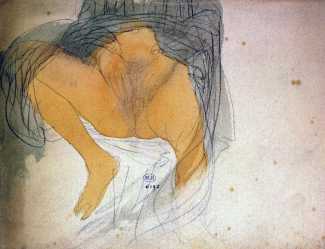 Some drawings lie at the far edge of eroticism and formalism. In one the immodest clarity of the genitals and spread thighs is emphasised by veiling the rest of the body with hatchings and a green wash. In another the strong contrast between the orange dress pulled up around the hips and the pale buttocks and legs, one form enclosing another, does not distract attention from the genitals, which are discreetly drawn in graphite but positioned in the centre of the image. The same is true of a third, where the woman’s presence is reduced to her genitals held open with both hands: the emphasis is triple – open dress, open legs, open genitals – but Rodin plays on the tension between the inverted forms of the thighs that spread upward and the dress that comes down over them, accentuating it by the contrast between grey and the colour of flesh.
Some drawings lie at the far edge of eroticism and formalism. In one the immodest clarity of the genitals and spread thighs is emphasised by veiling the rest of the body with hatchings and a green wash. In another the strong contrast between the orange dress pulled up around the hips and the pale buttocks and legs, one form enclosing another, does not distract attention from the genitals, which are discreetly drawn in graphite but positioned in the centre of the image. The same is true of a third, where the woman’s presence is reduced to her genitals held open with both hands: the emphasis is triple – open dress, open legs, open genitals – but Rodin plays on the tension between the inverted forms of the thighs that spread upward and the dress that comes down over them, accentuating it by the contrast between grey and the colour of flesh.




